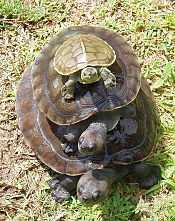Painted terrapin
| Painted terrapin | |
|---|---|
 | |
| Conservation status | |
| Scientific classification | |
| Kingdom: | Animalia |
| Phylum: | Chordata |
| Class: | Reptilia |
| Order: | Testudines |
| Suborder: | Cryptodira |
| Family: | Geoemydidae |
| Genus: | Batagur[1] |
| Species: | B. borneoensis |
| Binomial name | |
| Batagur borneoensis (Schlegel & Muller, 1844) | |
| Synonyms[2] | |
| |
The painted terrapin, painted batagur, or saw-jawed turtle (Batagur borneoensis) is a species of turtles in the Geoemydidae family. It was formerly in its own genus, Callagur, but has been reclassified to the genus, Batagur.[3]
Distribution
It is distributed in Brunei, Indonesia (Sumatra and Kalimanta), Malaysia, and Thailand.
Status
The painted terrapin is critically endangered species according IUCN, listed in The World's Most 25 Endangered Freshwater Turtles and Tortoises 2011.[4] It is listed in Appendix II, with a zero quota for commercial trade of wild-captured specimens according to the CITES meeting in Thailand, March 2013.
Batagur borneoensis is a priority species to be conserved in Indonesia according Minister of Forestry Decree No. 57 Year 2008 about Strategic Direction of National Species Conservation 2008–18. In Malaysia, this species is also protected.
Threats
Harvesting by fishermen to eat, poaching to meet pet and food demand, habitat loss due to land conversion to palm oil, and fish and shrimp farming are major threats.
Conservation
Conservation efforts in Sumatra, Indonesia, are ongoing to increase wild populations by carrying out nesting patrols to secure and hatch the eggs, for later release into original habitats.[5]
References
- ↑ Praschag, P., Hundsdörfer, A. K. & Fritz, U. (2007). Phylogeny and taxonomy of endangered South and South-east Asian freshwater turtles elucidated by mtDNA sequence variation (Testudines: Geoemydidae: Batagur, Callagur, Hardella, Kachuga, Pangshura). —Zoologica Scripta, 36, 429-442.
- ↑ Fritz Uwe; Peter Havaš (2007). "Checklist of Chelonians of the World". Vertebrate Zoology 57 (2): 213–214. Archived from the original on 2010-12-17. Retrieved 29 May 2012.
- ↑ Praschag, P., Hundsdörfer, A. K. & Fritz, U. (2007). Phylogeny and taxonomy of endangered South and South-east Asian freshwater turtles elucidated by mtDNA sequence variation (Testudines: Geoemydidae: Batagur, Callagur, Hardella, Kachuga, Pangshura). —Zoologica Scripta, 36, 429-442.
- ↑ Turtle Conservation Coalition (Rhodin, A.G.J., Walde, A.D., Horne, B.D., Van Dijk, P.P., Blanck, T., and Hudson,R.S (Eds)).2011. Turtles in Troubles: The World's 25 Most Endangered Tortoises and Freshwater Turtles-2011. Lunenburg. MA.IUCN/SSC Tortoise and Freshwater Turtle Specialist Group, Turtle Conservation Fund,Turtle Survival Alliance, Turtle Conservancy, Chelonian Research Foundation, Conservation International, Wildlife Conservation Society, and San Diego Zoo Global, 54 pp.
- ↑ Painted Terrapin Conservation Initiative, Satucita Foundation.
- Asian Turtle Trade Working Group 2000. Callagur borneoensis. 2006 IUCN Red List of Threatened Species. Downloaded on 29 July 2007.
External links
- Photos of Callagur borneoensis at Empire of the Turtle
- Freshwater Turtles and Tortoises Initiative in Sumatra: photos, education, field research, captive breeding
| ||||||||||||||||||||||||||||||||||||||||||||||||||||||||||||||||||||
| ||||||||||||||||||||||||||||||||||||||||||||||||||||||||||||||||||||||||||||||||||||||||||||||||||||||||||||||||||||||||||||

